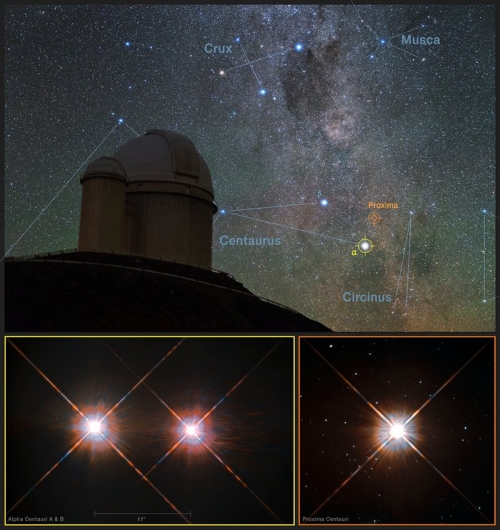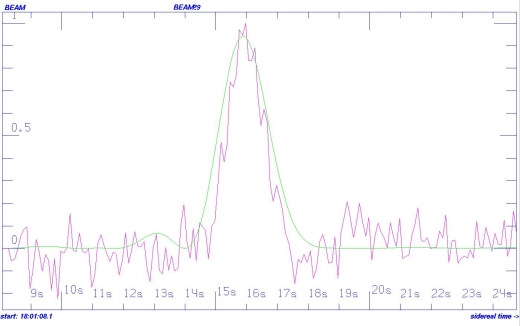Centauri Dreams
Imagining and Planning Interstellar Exploration
Breakthrough Starshot: Focus on the Sail
Who knows why and when we’re going to remember things? In the bus on the way to Moffett Field for the second morning of the Breakthrough Starshot meetings, I found myself thinking about Poul Anderson’s The Enemy Stars (1959). I had a paperback edition with a beautiful Richard Powers cover when I was a boy. What haunted me on that drive was the memory of what was written on the back:
They built a ship called the Southern Cross and launched her to Alpha Crucis. Centuries passed, civilizations rose and fell, the very races of mankind changed, and still the ship fell on her headlong journey toward the distant star. After ten generations the Southern Cross was the farthest thing from Earth of any human work – but she was still not halfway to her goal.
Breakthrough Starshot doesn’t plan to take that long to reach one of the Alpha Centauri stars (Alpha Crucis, by the way, is not one of them, but a multiple star system that is a part of the beautiful asterism known as the Southern Cross). The immensity of a journey between the stars still astounds me, after all these years of writing about it. At Moffett Field’s Building 18, we would be talking about ways to cross such gulfs. And while the long result is always at the back of your mind, it was time here in the Bay area to start talking about what can be done soon.
I have discovered that bilocation — being in two places simultaneously — is impossible. In the meetings at Moffett Field, I wanted to listen and take notes in each of the subcommittees, but stayed with just one, the sail group, because it seemed the best way to get a sense of the process as it worked itself out over the three days. Tough choice, because my respect for laser group leader Bob Fugate (New Mexico Tech) is immense, and I wanted to see how he and his team would deal with the early conceptualization of an unthinkably vast laser beamer. I also wanted more of the overview that Kevin Parkin’s systems engineering group was constructing.
Fortunately, our sessions frequently coincided as the subcommittees reported back to the full group, and it was possible to keep up to speed. The days were long, the debate fast-paced and productive, taxing my powers as a note-taker. But something Greg Benford said in the early going kept resonating with me throughout the meetings. “Nature bats last,” Greg commented after explaining his thoughts on beaming energy to a sail. In other words, we can produce idea after idea, but ultimately they’re going to be tested in simulations and in the laboratory, and we’re going to wind up with what works, not necessarily with our preconceptions.

Image: Did I mention that it was crowded when the full group met? This is from the first day of meetings, with several of the people from Breakthrough Listen also on hand to report on their own sessions.
Working on the Sail
We know what the long-term plan is: To develop and build a system that can deliver a payload to the Alpha Centauri system, said system to be perfected within a 20 to 30 year time frame, followed by 20 years of interstellar flight and a data return period of another 5 years. The plan is to send not one but many of these probes. In fact, if we are able to build a suitable beamer, we’re creating a reusable deep space infrastructure. Now, sitting in the board room at Moffett Field with afternoon sunlight slanting across the table, the sail committee was talking about the ‘short’ run, a 5-year period of technology development designed to lead to a prototype.
Technology development involves deep study of the concept, followed by simulations leading to laboratory work, and we were helped in the early sail discussions by the fact that Jim and Greg Benford, along with the University of New Mexico’s Chaouki Abdallah, had already performed laboratory work on microwave beamed sails using lightweight, highly temperature resistant carbon fiber. Out of this work’s simulations and experiments, the 4-meter sails envisioned for Breakthrough Starshot can grow conceptually and with new rounds of experimentation.
We have a sail that must achieve 20 percent of lightspeed and survive an intense period of acceleration lasting merely minutes. This is a craft that must be able to operate more than 20 years, given travel time and data return, and the sail that carries the payload must demonstrate stability on the beam, meaning that the slightest imperfection in design could cause it to simply be flung off-course. Moreover, the sail must be readily deployable, and it must be able to withstand the rigors of launch from Earth. The choice of materials for the sail flows directly from these requirements. Did I mention that we need to use the sail to return data to Earth? And that dust particles in the interstellar medium are a serious issue, though thought manageable?

Image: Work going on even during the breaks. This is mostly the sail committee, with Jim Benford at left, Breakthrough Starshot executive director Pete Worden, Greg Benford, Rafael Fierro, and Greg Matloff. I believe that’s Roald Sagdeev just behind Rafael.
We know that a beamed sail can be stable under a beam if it is spinning — the Benford/Abdallah lab studies have already demonstrated this (bringing the sail up to its initial spin, which involves sail deployment issues, is a key requirement). New rounds of simulation will be looking at matters like the best sail shape. A spinning conical shape is preferred, with the payload distributed in the lower part of the sail, which must be built so that a net sideways force tends to restore the sail onto the beam rather than pushing it off. The spin imparted to the sail comes from initial deployment, as previously demonstrated in tests at JPL. The sail becomes stabilized against pitch and yaw, but the center of force must always be above the center of mass.
This last, by the way, is why a rocket is not stable. The center of force is actually below the center of mass in this case, a situation we don’t want to see on the sail, which is why the payload cannot be placed on top of the sail. And given the power levels the team plans to put onto the sail, we have to identify issues that have so far escaped us. “In terms of beam-riding and stability,” Jim Benford noted, “we are going to learn new problems we have not thought of yet. That’s why we have to get to experiments sooner rather than later.”
The sail committee debated these matters much of the afternoon on the first and second day, a team involving Lou Friedman (Planetary Society), Mason Peck (Cornell), Starshot director of engineering Pete Klupar (who would move between sail and laser meetings), Kelvin Long (i4IS), Zac Manchester (Harvard), Raphael Fierro (UNM), Greg Matloff (CUNY), Chaouki Abdallah (UNM) and both Benfords. Jim Benford, who chaired the sail meetings, pointed to the need for experiments both vertical and horizontal, the vertical to test stability and spin, the horizontal to test acceleration.
To get moving quickly, the sail committee decided to identify and contact industrial, academic or governmental research groups that can be of help, with a workshop on sail materials as soon as the end of September. Work on simulations can likewise begin quickly, with sails tested in a vacuum under a variety of accelerations. If the laser for this early testing cannot be provided in that timeframe, microwaves can be a stand-in, with a variety of advantages of their own. Meanwhile, the analysis, simulation and fabrication will involve multiple contracts, with down-selection at the end for the best solution to the complicated sail requirements.
As I mentioned the other day, a Request for Proposal (RFP) is already being drafted — we worked on this the last day of the meeting, at the hotel. Results on that should begin to emerge in the spring of 2017, even as Breakthrough Starshot begins trade studies that will help in the evaluation of these proposals. The RFP will help to select the people who can do the first round of studies. Stability testing on the sail can begin relatively soon, Jim Benford said, while developing the requirements for acceleration will depend on chosen contractors.

Image: Late in the morning of the last day, the sail committee, consulting at the hotel with laser subcommittee leader Bob Fugate. From left, Greg Benford, Mason Peck, Zac Manchester. I think that’s Wes Green (Tau Technologies) just behind Zac, then Jim Benford, and Bob Fugate. Not visible at the end of the table: Greg Matloff and Rafael Fierro.
Deep Space Reminiscences
With Anderson’s The Enemy Stars still bouncing around in my head, I joined the Starshot team for an evening at a local restaurant. I was fortuitously placed directly across from Olivier Guyon (University of Arizona) and Slava Turyshev (JPL), which led to conversations about all of us and how we got involved at an early age in space. I always ask the scientists I talk to about this, and it invariably generates discussions about long-remembered favorite books and movies. Few of us have just one key driver, and I can recall films like Destination Moon as well as the Anderson novel among numerous other books and short stories.
Guyon recalled the Fantômas books, a long series by various French authors involving wild plots and inventive gadgetry — with an anti-hero main character to boot. Turyshev had read some of these in the Soviet Union and had even built his own versions of some of the unusual technologies, like a flying car with retractable wheels. Novels were my own introduction, especially the Heinlein juveniles, and Jim Benford jumped in with his own reminiscences of such titles as Have Spacesuit Will Travel (for me, it was Starman Jones). Amidst all this, Ed Turner (Princeton) and I squeezed in a talk about his travels in Japan.
Conversation flows easily after days of data crunching and analysis (wine doesn’t hurt, either). But the size of the project was something that stayed with me throughout these meetings, and it was only reinforced by the memory of Heinlein and science fiction’s Golden Age. Walking back to the hotel on a fine Palo Alto evening with Claire Max and Kevin Parkin, I found myself pondering the audacity of a star mission. “They built a ship called the Southern Cross and launched her to Alpha Centauri…” Name aside, it’s the plan, though the ‘ship’ is nothing like Anderson’s. It’s small, sail-driven, and can be sent out in swarms. It will need to travel 4.2 light years, fully 260,000 AU (if Proxima is the target, another 10,000 AU or so if it’s Centauri A or B). And what put me in an irresistibly light mood was the thought that the physics does not preclude it. The engineering, though, is another matter, and a key focus of all these deliberations.

Proxima b: Obstacles and Opportunities
Meeting people I’ve written about is always a pleasure at gatherings of the interstellar-minded, and I was delighted to run into Victoria Meadows (University of Washington) in the lobby of our hotel on the final day of the Breakthrough Starshot meetings. Rory Barnes is a colleague of Meadows at UW and recently described the research underway at the Virtual Planetary Laboratory there, at which Meadows is the director. Barnes’ essay Opportunities and Obstacles for Life on Proxima b appeared as a guest post on the Pale Red Dot site. I wished I had time to discuss Proxima with Meadows, but our meeting was brief as everyone dispersed for dinner.
What Meadows and fellow researchers Giada Arney, Edward Schwieterman and Rodrigo Luger are doing is to produce computer models through which they can study Proxima b’s habitability, based on everything from the planet’s orbit to the characteristics of not just its host star, but the nearby stars Centauri A and B. Out of this come conclusions about the possibility of life, not all of which are positive. We’re reminded that being in the habitable zone is just one of a series of complex requirements for producing sustainable life on a planet.
Let’s review what we’ve learned so far about Proxima b in the short time since its detection. Its year is 11.2 days in an orbit that may or may not be circular. The planet seems to be a bit more massive than the Earth, and we may learn that it is several times as massive. Its host star, Proxima Centauri, is only 12 percent as massive as the Sun, and like many red dwarfs, it is known to be a flare star. Whether or not it is gravitationally bound to Centauri A and B remains an open question, though most astronomers I’ve talked to think that it is. As I did yesterday, I’ll also refer you to Andrew LePage’s Habitable Planet Reality Check: Proxima Centauri b.

Is Proxima b a rocky world? Barnes thinks the odds on that are good. As explained yesterday, radial velocity methods, by which Proxima b was detected, can provide no more than a minimum mass. Few of the possible orbits for Proxima b that are consistent with the data — only about 5 percent of them, in fact — yield a planet above 5 Earth masses, which is good news for a rocky composition. We’ve already discussed factors like tidal lock and flares from the host star, but Barnes brings another issue into the mix. Just how did this planet evolve?
Here’s the issue in a nutshell:
The history of Proxima’s brightness evolution has been slow and complicated. Stellar evolution models all predict that for the first one billion years Proxima slowly dimmed to its current brightness, which implies that for about the first quarter of a billion years, Proxima b’s surface would have been too hot for Earth-like conditions. As Rodrigo Luger and I recently showed, had our modern Earth been placed in such a situation, it would have become a Venus-like world, in a runaway greenhouse state that can destroy all of the planet’s primordial water.
All of this flows from what happens at the molecular level, as Barnes explains:
This desiccation can occur because the molecular bonds between hydrogen and oxygen in water can be destroyed in the upper atmosphere by radiation from the star, and hydrogen, being the lightest of the elements, can escape the planet’s gravity. Without hydrogen, there can be no water, and the planet is not habitable. Escaping or avoiding this early runaway greenhouse is the biggest hurdle for Proxima b’s chances for supporting life.
Image: The University of Washington’s Rory Barnes, whose work focuses on planets in and around the “habitable zones” of low-mass stars, showing how their composition, orbital oscillations, and tidal processes affect our concept of planetary habitability. Credit: UW.
So we have a habitable zone that, over time, moves inward, with the distinct possibility that Proxima b might have lost its water in the first ten million years of its existence. Even if some water remains, Barnes writes, the atmosphere may then contain large quantities of oxygen, a reactive element that could well have prevented the formation of prebiotic molecules. Our own Earth eventually developed oxygen through photosynthesis, but life formed here in the absence of oxygen. We have an odd scenario here, the possibility of a planet with surviving oceans and an atmosphere rich in oxygen, but one that is unable to produce life in the first place.
We’ll be investigating all this with future space-based missions as well as observations on the ground. As to Meadows’ work at the Virtual Planetary Laboratory, it’s related to distinguishing the possible conditions in Proxima b’s atmosphere through spectral analysis. We may be able to discern oxygen features in a spectrum that will help us decide whether there is too much oxygen for life to form, or an amount of oxygen that would be compatible with living systems.

Image: This picture combines a view of the southern skies over the ESO 3.6-metre telescope at the La Silla Observatory in Chile with images of the stars Proxima Centauri (lower-right) and the double star Alpha Centauri AB (lower-left) from the NASA/ESA Hubble Space Telescope. Proxima Centauri is the closest star to the Solar System and is orbited by the planet Proxima b, which was discovered using the HARPS instrument on the ESO 3.6-metre telescope. Credit:
Y. Beletsky (LCO)/ESO/ESA/NASA/M. Zamani.
Barnes tends to dismiss atmospheric collapse as the result of tidal locking, saying that winds in the atmosphere should transport energy and keep the nightside from freezing out. But as Centauri Dreams readers know, Barnes is deep into the investigation of tidal effects. Here he describes how tides can provide large amounts of energy to a planetary interior:
This energy is often called “tidal heating” and is a result of the deformation of the planet due to changes in the host star’s gravitational force across the planet’s diameter. For example, if the planet is on an elliptical orbit, when it is closer to the star, it feels stronger gravity than when it is farther away. This variation will cause the shape of the planet to change, and this deformation can cause friction between layers in the planet’s interior, producing heat. In extreme cases, tidal heating could trigger the onset of a runaway greenhouse like the one that desiccated Venus, independent of starlight.
Proxima b is not likely to be in this state, according to Barnes, but he still sees the possibility of continual volcanic eruptions — think Io — and huge oceanic wave activity related to this. As to flaring, much depends on whether Proxima b’s atmosphere could be shielded by a strong magnetic field. Alternatively, life could develop under relatively shallow levels of water.
Barnes discusses all these issues in two new papers on which the Pale Red Dot essay was based, reminding us how much we have to learn before we can make the call on Proxima b’s habitability. There is some evidence for a second planet around Proxima Centauri, one that could perturb Proxima b’s orbit and supply energy to its interior. As we learn more, we’ll discover whether a star that can live for trillions of years can sustain life on the planets that crowd near it. Observations and simulations will proliferate, and if Breakthrough Starshot succeeds, we may in the latter part of this century see Proxima b close up.
There are two Rory Barnes / Virtual Planetary Laboratory papers to consider. The first is “The Habitability of Proxima Centauri b I: Evolutionary Scenarios,” submtted to Astrobiology (preprint). The second is “The Habitability of Proxima Centauri b: II: Environmental States and Observational Discriminants,” submitted to Astrobiology (preprint).

A Closer Look at Proxima b
I have much more to say about the Breakthrough Starshot meetings, but last evening I decided to slow the pace a bit. I mentioned in my first report that the discovery of a planet around Proxima Centauri had woven through our San Francisco meetings, creating a bright thread of discussion that continued through all three days. We are also getting papers on Proxima’s planet that inform us more about its potential habitability. In the next couple of days, then, I want to go through some of these before returning soon to the broader issues of Starshot.
I also have to admit that I am still transcribing some of my handwritten notes from San Francisco to get everything in synch with my laptop, a process that is taking longer than I intended, thanks to my murky handwriting…
In any case, whether Proxima b is habitable or not would surely play a large role in any decisions about using it as Starshot’s initial target. So let’s remember what Guillem Anglada-Escudé and the Pale Red Dot team had to say about the planet’s placement, which they describe as “…squarely in the center of the classical habitable zone for Proxima.” I also want to quote briefly from the reliable Andrew LePage, whose Habitable Planet Reality Check: Proxima Centauri b is a post you’ll want to read. Here LePage sums up what we know so far:
Based on the limited data we currently have about Proxima Centauri b, it seems to be potentially habitable, although not very Earth-like. Its MPsini of 1.27 ME suggests that it is a rocky planet instead of a mini-Neptune with little prospect of being habitable in the conventional sense. It is also located inside the habitable zone (HZ) of its host star and detailed 3D global climate models suggest that it could be habitable over a wide range of realistic conditions. Comparing it to other potentially habitable exoplanets currently known (a short list dominated by planets of other red dwarfs), Proxima Centauri b is probably one of the most promising, on par with Kepler 186f…

Image: Announcing Proxima b. On 24 August 2016 at 13:00 CEST, ESO hosted a press conference at its Headquarters in Garching, near Munich, Germany. Speaking here is Dr. Guillem Anglada-Escudé. That’s Breakthrough Starshot executive director Pete Worden behind him at far right. Credit: ESO/M. Zamani.
Note the reference to MPsini, which refers to an essential problem with radial velocity studies. We can’t know how a given exoplanet’s orbit is tilted in relation to our view from Earth. The practical result is that the answer we obtain for a planet’s mass is only a minimum. We can see that it is affecting its star, but we have no way of knowing (unless we have a transit) whether we are seeing the system at a steep or shallow angle. So we’re really dealing with a set of possibilities about the actual range of a planet’s mass.
Anglada-Escudé and team calculate a mass for Centauri b of ~1.3 M? (i.e., 1.3 times the mass of the Earth). As to its size, another quote from LePage:
Based on statistical analysis of Kepler results performed by Leslie Rogers (Hubble Fellow at Caltech) and others, it is known that exoplanets seem to transition from being predominantly rocky to predominantly volatile-rich probably at a radius of about 1.5 RE and certainly no greater than 1.6 RE (see “Habitable Planet Reality Check: Terrestrial Planet Size Limits”). A planet with this radius corresponds to a mass of about 6 ME, assuming an Earth-like composition. With an unconstrained orbital inclination, there is about a 98% chance that Proxima Centauri b with a MPsini of 1.27 ME has an actual mass below this threshold.
LePage also looks at a paper I haven’t studied yet from Martin Turbet (Laboratoire de Météorologie Dynamique, Sorbonne Universités) and colleagues which studies climate models for Centauri b. The finding here is that this planet could support liquid water on the surface, making the case that the planet is at least potentially habitable.
JWST: Focusing in on Proxima b
Avi Loeb is chairman of the Breakthrough Starshot Advisory Committee. The Harvard physicist, who led our discussions in San Francisco, has also produced (with Harvard’s Laura Kreideberg) a new paper on Proxima b that advances our discussion. What Loeb and Kreideberg look at is the question of how we can learn more about the atmosphere of this planet, which in turn goes a long way toward illuminating potential habitability. The paper reminds us early on that the amount of stellar radiation reaching the planet is about two-thirds what we receive on Earth. The prospects for habitability really are enticing but we must have a way to confirm them.
The issues here are more serious than they may seem at first glance. We don’t know whether Proxima b even has an atmosphere. Remember that in order to have suitable temperatures for liquid water, this world must orbit very close to its small star, at about ?0.05 AU. That’s going to make for probable tidal lock, with one side of the planet continuously turned toward Proxima Centauri, the other away from it. It is not inconceivable that an atmosphere can collapse; i.e., we wind up with a world whose atmosphere is largely frozen out on the night side. We also face the possibility that atmospheric erosion from stellar winds can strip the world of its envelope.
We’re going to learn soon, through David Kipping’s work with data from the Canadian MOST satellite, whether a transit can be detected here, but the odds hover around 1 percent. In the absence of a transit, Loeb and Kreideberg look at what they consider the best option for characterizing an atmosphere: Measuring variations in its heat as it orbits Proxima.
The idea is this: A tidally locked planet will expose more or less of its hot dayside to the observer as it orbits the star (as seen from Earth). We should thus get thermal variation, which allows us to compare what we observe with models for a world with various kinds of atmosphere. If the planet has no atmosphere at all, this ‘thermal phase variation’ will be different from what we would see if an atmosphere is present, for an atmosphere would redistribute heat from dayside to nightside, changing the profile of the temperature variation over time.

Image: Figure 2 from the Loeb/Kreideberg paper. Caption reads: Thermal phase curves for a bare rock (left) and a planet with 35% heat redistribution. The models both assume an inclination of 60 degrees and an albedo of 0.1. Credit: Loeb & Kriedeberg.
The James Webb Space Telescope, to be launched in 2018, may be a key component in this work. The paper proceeds to outline the kind of observational test that could confirm the existence of an atmosphere on Proxima b. It is a combination of observing strategies from ground and space that seeks to measure the possible redistribution of heat. From the paper:
In the case of no redistribution, one could infer the planet does not have an atmosphere and is unlikely to host life. By contrast, if we do find evidence for significant energy transport, this would indicate that an atmosphere or ocean are present on the planet to help transport the energy. In that case, Proxima b would be a much more intriguing candidate for habitability. Either way, these observations will provide a major advance in our understanding of terrestrial worlds beyond the Solar System.
Observations with the JWST in the 5 ? 12 micron regime, the paper argues, can distinguish between bare rock and a world with 35 percent heat redistribution to the nightside at a high level of confidence. Longer observations can tell us whether an Earth-like atmosphere exists by detecting ozone absorption. Here it’s interesting that we can use an existing space instrument to begin the investigation:
This model assumes an Earth-like atmospheric composition irradiated by a GJ 1214b-like star. We note that the presence of ozone is sensitive to the ultraviolet (UV) spectrum of the host star (Rugheimer et al. 2015), which can vary for M-dwarfs even of the same spectral type (France et al. 2016). UV spectroscopy of Proxima should therefore be a priority while it is still possible with the Hubble Space Telescope.
A combination of our tools, then, can be applied to this task, one that would mark our first cut into the question of possible life around the star nearest our own. More thoughts on Proxima b’s habitability, as seen in a new paper from Rory Barnes (University of Washington) tomorrow.
Today’s paper is Loeb & Kreideberg, “Prospects for Characterizing the Atmosphere of Proxima Centauri b,” submitted to Astrophysical Journal Letters (preprint).

Breakthrough Starshot Report 2: Drilling Down to the Basics
A lot of things can go wrong when you’re working on a thirty-year project. Consider the charter of the systems subcommittee of Breakthrough Starshot, whose mission is to “…ensure that Starshot engineering activities can and will result in a 0.2c mission to Alpha Centauri.” In the hands of the capable Kevin Parkin, the subcommittee has oversight over a systems team that will conduct system engineering, modeling and integration activities.
I call Parkin ‘capable’ but, like so many of the people I dealt with at the recent meetings in San Francisco, he strikes me as flat-out brilliant. He’s also a strategic thinker who knows how to communicate. Parkin’s presentation on how to structure a project as complex as Starshot included classic failure modes of past projects, such as team members working with differing assumptions, a focus on details and not on the whole, and a focus on the whole and not on the details. Any one of these can trip you up. Walk a fine line, in other words, and try to avoid duplication of effort through careful information management and sound communications.
As I took notes, I thought of something Greg Benford said in Dining with Dirac, an account of a dinner that included Stephen Hawking and Paul Dirac, not to mention Martin Rees: “This is an evening to keep your mouth shut.” I kept mine shut and applied myself to typing faster.
Pete Klupar would sound some of the same themes that Parkin did as we met at Moffett Field that morning, noting as well that long projects like these can be in danger of ‘loss of memory’ as the original team is gradually replaced over time. And something that came up at various points in the discussion kept haunting me as I prowled the grounds at Moffett during our breaks, trying to get my daily walk in while I put the meetings in perspective. A big project has to avoid getting locked in too early. The basic assumptions have to be looked at before it’s too late to change them. We’ll be talking about that more in coming days.

Image: The advisory committee at work. From left (facing the camera): Robert Fugate (New Mexico Tech), Jeff Kuhn (University of Hawaii), Jim Benford (Microwave Sciences), Claire Max (UC-Santa Cruz). Facing away from the camera from left, Mason Peck (Cornell), Kelvin Long (i4IS), Bruce Draine (Princeton), Kevin Parkin (Parkin Research) and Greg Benford (UC-Irvine). Geoff Landis (not pictured here) joined in for a time online from NASA Glenn.
Shadow of the Airship
I tried to see the big picture of Starshot as I walked on a break that first afternoon, enjoying the Bay area’s benign climate. Moffett Field is the home of the famous ‘Hangar One,’ an airship hangar built during the Depression era to house the USS Macon. From Building 18, where we worked, the steel girders of the stripped hanger dominate the view (its exterior panels were removed in 2011). Walking near it is an experience of immensity, with a floor covering eight acres, so large that fog used to form near the ceiling. It was impossible to approach it without thinking of the engineering that went into dirigibles.
The great age of airships ended with the death of the Hindenburg in 1937, though it had been presaged by the loss of the hydrogen-filled British airship R101 in 1930. Moffett Field is itself named after Rear Admiral William Moffett, who died aboard the USS Akron, a helium-filled airship, in 1933. Theories abound as to the loss of the Hindenburg, but it’s understood that inert helium is by far the safer gas. You could call the use of hydrogen a systems engineering choice, but in this case it was one forced on designers by the US embargo on helium to Germany.
The point is, you have to look for any factor that can take a project down, no matter the expediency of one choice over another. What Breakthrough Starshot wants to do is so breathtaking that it’s necessary to stand back and remember its parameters. A plan over three decades to design, simulate and experiment, creating a prototype of a craft that can reach another star, and then actually build such a craft after new infusions of capital demands unique flexibility and what the meeting was there to consider, a careful plan for the early going.

Image: Hangar One at Moffett Field, now a skeletal reminder of the era of enormous airships. Technological change can be abrupt and disruptive, reinforcing the challenging nature of long-range planning. How to make sensible choices in the early going is a huge question.
To Reach a Star
One choice that team members seemed comfortable with is the choice of a sail to reach the target star, presumably in the Alpha Centauri system, although not necessarily Proxima Centauri b. Aboard the sail would be a small payload, perhaps the size of a smartphone, perhaps even smaller, that is built around what the project is calling a StarChip. We’re talking a payload that is measured in grams rather than kilograms, using breakthroughs in miniaturization to fold in communications, navigation, cameras, power supply and LED-like ‘thrusters.’
The early discussions have included a sail of about four meters to the side, itself weighing no more than grams. The sail has advantages that place it far above any other propulsion methods available today. Chemical rockets require far too much propellant to even consider a star mission. Fusion is not available. A sail can be placed under a beam of directed energy that drives it, planners hope, to twenty percent of the speed of light. In the initial Starshot concept, that beam of energy comes from a colossal phased array of lasers, to be built in southern latitudes. The Atacama desert of Chile is often mentioned.
A sail pushed to 20 percent of the speed of light could blow past the Alpha Centauri system after about twenty years of flight time, returning data to Earth if a way can be found to do this, presumably through ‘swarm’ technologies that would leverage the fact that Starshot is not one sail but hundreds, perhaps thousands. Multiplying the number of sails offers the kind of redundancy that allows for projected losses through collisions with dust in the interstellar medium. I listened with fascination to Bruce Draine’s thoughts on the ISM. He is, after all, author of Physics of the Interstellar and Intergalactic Medium (Princeton, 2010).

More on that issue later, though the consensus seems to be that sails and payloads can survive the journey, with some losses along the way. As with the entire concept, you can see that there are showstoppers even when we get to the target star. Just how is that data return managed through payloads as tiny as these? Can the beam array also be a receiver? Can the sail itself become an optical element, a receiver as well as a transmitter, on demand?
I’ve gone through the long list of problem areas in these pages before (see Starshot: Concept and Execution). In San Francisco, we also considered the timeline. The systems subcommittee was in place, and separate subcommittees had been formed for both the laser beamer and the sail, with New Mexico Tech’s Robert Fugate in charge ot the former, Jim Benford of the latter. When we weren’t meeting in joint session, I spent my time in the sail committee, wishing I could be in two places at once, but also fascinated by the early plans for simulations and experimental work to follow up what Jim, brother Greg Benford and Chaouki Abdallah had already done on beamed sails some years back. Thanks to them, we already have beamed sail lab data.
Image: Sail pioneers. Jim Benford, right, talks to Greg Matloff. Benford and brother Greg performed early lab work on beamed sails that will now be extended in new directions. Matloff, inspired by Robert Forward, has written numerous papers on sail technologies, beginning with the classic “Solar Sail Starships: The Clipper Ships of the Galaxy” (Journal of the British Interplanetary Society, Vol. 34, pp. 371-380, 1981).
I should also mention that the San Francisco meetings followed two days of Breakthrough Listen discussions, focused on the effort Yuri Milner launched with a $100 million donation to the SETI effort. I wasn’t able to attend these, although we did have a report from members of the SETI community on what they had accomplished. I’ll try to get to that some time this week.
But back to that Starshot timeline. After a discussion of systems drivers — measures of performance, as Pete Klupar explained in his presentation, and tools that show how well a system meets its goals — Klupar projected a roadmap showing a research and development phase lasting roughly eight years, to be followed by a period of ‘sub-scale testing’ that presumably involves construction of a prototype. Construction of the beamer system and sail could, in Klupar’s chart, begin in the early 2030s, with a launch perhaps as early as the mid-2040s. Needless to say, these are estimates and by their nature flexible.
People keep asking me how you can think about building a system that will allow interstellar flight for $100 million, the amount Yuri Milner donated to establish the project. The answer is, you can’t, but the $100 million isn’t for the entire mission. What the systems subcommittee reported on was $100 million for technology analysis and development over a span of five years, to be followed by a prototype that would take the cost up to $1 billion. The lowest estimate I’ve seen for an actual mission with these technologies is $10 billion, leaving future funding issues to be decided, although presumably success in the early going could encourage wealthy philanthropists to repeat Milner’s gesture with money of their own.
I’m running out of time this morning, so I’ll end here. Tomorrow what I want to do is get into the issue of early simulation and testing, as seen through the deliberations of the sail committee. On the final day of our meetings, this time meeting in the hotel rather than at Moffett Field, the sail group began writing a draft of what will become its first RFP — Request for Proposal — a solicitation that involves bidding to fulfill the requirements defined by the committee. More on this, and on how it will affect the first sail experiments, tomorrow.

At the Breakthrough Starshot Meetings
An interesting typo — I had started to write ‘On the plane back from Proxima b,’ still a bit groggy from lack of morning coffee. Let’s correct that to ‘On the plane back from San Francisco.’ I was coming back from the Breakthrough Starshot meetings, most of which took place at Moffett Field, a former naval air station that NASA owns through its adjacent Ames Research Center. Presume no NASA involvement, though — Moffett Field is used by many and includes three university branch campuses as well as the building leased by Breakthrough Starshot.
My plan had been to settle in on the plane with my notes as I worked out what to say about the trip. Instead, I succumbed to sleep for a good part of the journey. I had slept well each night, but the meetings were intense and the note-taking non-stop. I arrived two hours after the first of them began in a small boardroom, wedged myself into a chair in the corner after nodding hello to a number of familiar faces, and began taking notes by hand, since the space was too tight for my laptop. Fortunately, things sorted themselves out after the break and I could type again.
The Cast of Characters
Looking around the table, I could see Cornell’s Mason Peck, whose work on ‘sprites’ — tiny ‘spacecraft on a chip’ — has long been a topic of conversation in these pages, and one that fits tightly into the Breakthrough Starshot concept. Former Planetary Society director Lou Friedman was there, a sail pioneer who had worked with NASA’s early concept for a Halley’s Comet mission and who led the Society’s initiative into launching small sails into space. Greg Matloff (CUNY) was down the row, an interstellar researcher whose book The Starflight Handbook was the trigger for my own decision to go deeply into the topic; his wife, the artist C Bangs, was not at the meetings, but we had an enjoyable dinner conversation and museum tour.
Pete Worden is executive director of Breakthrough Starshot, a former director of NASA Ames, while Pete Klupar is the project’s director of engineering, a role he also played at Ames. Across the table I saw astrophysicist Claire Max (UC-Santa Cruz), Kelvin Long (Initiative for Interstellar Studies), software architect Kevin Parkin (Parkin Research), Roald Sagdeev (University of Maryland), the former director of the Space Research Institute in Moscow, and Princeton astrophysicist Ed Turner. I would soon meet exoplanet hunter Olivier Guyon (University of Arizona), Princeton astrophysicist Bruce Draine, Larry Krauss (Arizona State), Wes Green (Tau Technologies), and Nobel Prize winner Saul Perlmutter, who appeared at one of the dinners.
Martin Rees, Britain’s Astronomer Royal, was at the corner of the table, a cosmologist and astrophysicist I was delighted to meet for the first time at lunch that day. Microwave and plasma physicist Jim Benford would come in shortly after I did; his brother Greg arrived that night. Mae Jemison was there from 100 Year Starship, as was Phil Lubin, whose ideas on lasers had led to consideration of building a beamer in southern latitudes to drive Starshot’s fleet of small sails. Laser and adaptive optics specialist Bob Fugate headed up the beamer subcommittee (Jim Benford led the sail group) and Harvard’s Avi Loeb chaired the meetings.
There are too many people to simply list here — I’ll let these and others speak in the rest of my reports on Breakthrough Starshot. Suffice it to say that many people I had written about before on Centauri Dreams were involved in these meetings, some of whom I was encountering in person for the first time. There would be plenty of time to talk at the dinners each night and I’ll be reporting on some of these conversations, such as a fine evening talking to JPL’s Slava Turyshev and Olivier Guyon, and Indian food with the Benfords and UNM’s Rafael Fierro. Drinking a Sazerac with Jim Benford and UNM’s Chaouki Abdallah was a highlight.

Fig02: Facing the camera at the end of the table on the left is Martin Rees. That’s Lou Friedman behind him, Slava Turychev, Kevin Parkin, Mason Peck (behind Mason is Roald Sagdeev, although hard to see). On the other side of the table, from the left with backs turned, is Larry Krauss, Claire Max, Phillip Lubin, Mae Jemison and Pete Klupar. The picture doesn’t catch many of the people sitting around the sides of the room. When we met in full committee, it was a tight but manageable squeeze. The subcommittee scenes were roomier.
The Entwined Proxima Centauri b
On the flight out, I had spent a good bit of time tweaking what I wanted to say about Proxima b. I had the discovery paper in my bag and had already written a rough draft that I would publish when the embargo lifted. As you might imagine, Proxima b was much on the minds of the Breakthrough team, all of whom were well aware of Pale Red Dot’s accomplishment in finding a provocative planet around the nearest star. The subject would dominate many conversations.
I’ve seen some reports that the discovery of Proxima’s planet has given Breakthrough Starshot its target. But I think this is a mistaken assumption. In fact, no target has yet been chosen because it’s far too early to make such a choice. What Proxima b does deliver is the first planet around another star within range of this project. We shouldn’t assume it will be the last.
Remember that we are dealing with a multi-decade project, one I’ll sketch out in more detail in tomorrow’s post. That means we have some time to work out the best choice of destinations. And right now we have not just Proxima Centauri on our doorstep, but also Centauri A and B, the former a G-class star a bit larger than the Sun, the latter a K-class dwarf of considerable interest. Either of these could have planets of their own, and within the decade or perhaps a bit beyond, we should be able to make a definitive statement about further possibilities.

The fact that we can’t do more with Centauri A and B right now is because their angular separation in the sky is too tight. In fact, as seen from Earth, they closed to within their closest distance last spring. In coming years, as the separation again widens, we should be able to bring our radial velocity tools to bear to again delve into possible planetary systems there.
Which would you choose, if the choice were between a terrestrial-class world in the habitable zone around, say, Centauri B and a planet of similar size and interest around Proxima? My suspicion is that the Centauri B world would receive the nod, but bear in mind even as I say this that Breakthrough Starshot is envisioning not one but thousands of small sailcraft. If that scenario occurs, and given the fact that once a beamer has been built on Earth it will become a tool that can be used for many missions, we will eventually explore all three Centauri stars.
Image: Building 18 at Moffett Field. Most of the buildings in this area were built in the 1920s or so, an unusual setting for starship deliberations, but I enjoyed the irony. I also learned that Breakthrough Initiatives has purchased new facilities in downtown Palo Alto.
But I don’t think anyone at the Breakthrough Starshot meetings will forget the buzz that Proxima Centauri b caused. It is our first detected world around the closest stellar system (Centauri B’s lone planet is widely considered to have been an artifact of activity on the star itself, misread as a planetary signature), and at a dinner on the second night, the scientists who spoke enjoyed referring to ‘a rumored planet’ around Proxima. It always brought a laugh because everyone knew it was the real deal, and the announcement would be the next day.
Tomorrow I’ll take a broader look at Breakthrough Starshot, its aims and possible schedule, while working in more observations from the various meetings both official and social. As we’ll see, the number of breakthroughs needed here is formidable, and my belief is that the mission outline will change substantially as the early simulations and experimental work are performed.
As occurs at any such conference, a lot of things get done at meals and in the hallways as the proximity of researchers sparks ideas. I tried to keep my head down and my ears open, so we’ll have a lot to talk about in coming days.

An Interesting SETI Candidate in Hercules
A candidate signal for SETI is a welcome sign that our efforts in that direction may one day pay off. An international team of researchers has announced the detection of “a strong signal in the direction of HD164595” in a document now being circulated through contact person Alexander Panov. The detection was made with the RATAN-600 radio telescope in Zelenchukskaya, in the Karachay-Cherkess Republic of Russia, not far from the border with Georgia in the Caucasus.
The signal was received on May 15, 2015, 18:01:15.65 (sidereal time), at a wavelength of 2.7 cm. The estimated amplitude of the signal is 750 mJy.
No one is claiming that this is the work of an extraterrestrial civilization, but it is certainly worth further study. Working out the strength of the signal, the researchers say that if it came from an isotropic beacon, it would be of a power possible only for a Kardashev Type II civilization. If it were a narrow beam signal focused on our Solar System, it would be of a power available to a Kardashev Type I civilization. The possibility of noise of one form or another cannot be ruled out, and researchers in Paris led by Jean Schneider are considering the possible microlensing of a background source by HD164595. But the signal is provocative enough that the RATAN-600 researchers are calling for permanent monitoring of this target.

Image: The RATAN-600 radio telescope in Zelenchukskaya. Credit: Wikimedia Commons.
Here I’m drawing on a presentation forwarded to me by Claudio Maccone, from which I learn that the team behind the detection was led by N.N. Bursov and included L.N. Filippova, V.V. Filippov, L.M. Gindilis, A.D. Panov, E.S. Starikov, J. Wilson, as well as Claudio Maccone himself, the latter a familiar figure on Centauri Dreams. The work is to be discussed at a meeting of the IAA SETI Permanent Committee, to be held during the 67th International Astronautical Congress (IAC) in Guadalajara, Mexico, on Tuesday, September 27th, 2016,
What we know of HD 164595 is that it is a star of 0.99 solar masses at a distance of roughly 95 light years in the constellation Hercules, and an estimated age of 6.3 billion years. Its metallicity is almost identical to that of the Sun. A known planet in this system, HD 164595 b, is 0.05 Jupiter mass with a period of 40 days, considered to be a warm Neptune on a circular orbit. There could, of course, be other planets still undetected in this system.
Image: Strong signal from the direction of HD 164595. “Raw” record of the signal together with expected shape of the signal for point-like source in the position of HD 164595. Credit: Bursov et al.
From the presentation:
The estimated probability ~2 X 10-4 to simulate the signal from the direction of the HD164595 by signal-like noise is small, therefore HD164595 is good candidate SETI. Permanent monitoring of this target is needed.
All of which makes excellent sense. We can’t claim the detection of an extraterrestrial civilization from this observation. What we can say is that the signal is interesting and merits further scrutiny.




